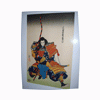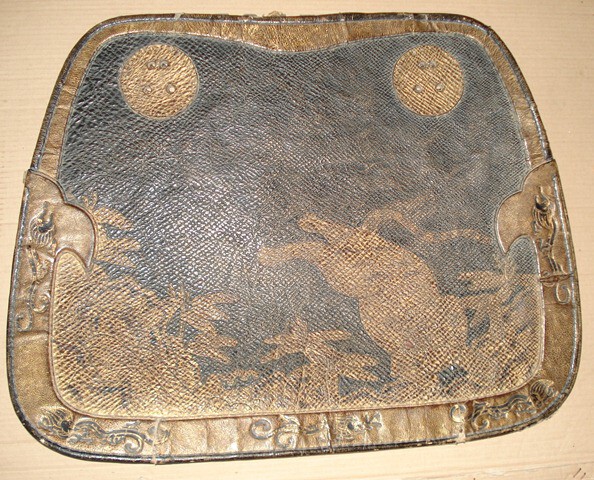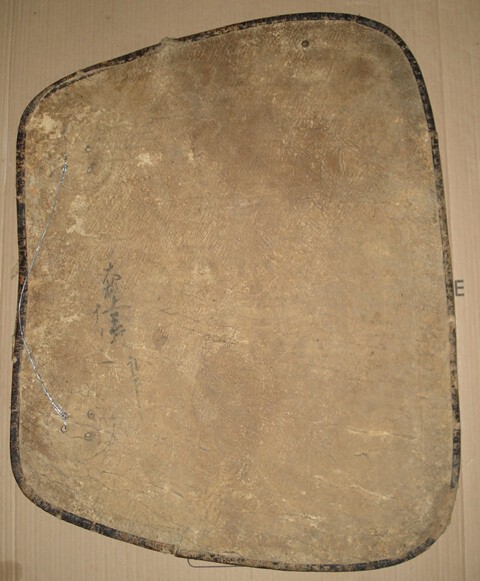-
Posts
334 -
Joined
-
Last visited
Everything posted by edzo
-
Hi to all, A friend purchased these Aori recently and wondered if they were late 17th or early 18th century. To me they look to have a chinese style primarily because of the embossed dragons on the border. They are very heavy hide lacqured blak and then in gold depictinh a leaping tiger looking back. The reverse includes some Japanese characters I cannot read, perhaps someone will pitch in, Thanks, Ed, hope u enjoy them in any event.
-
Thanks Dave M, Ed F
-
Did it, Ed
-
Hi members, I have come up with Noshu ju Toki Kanemasa. I'm not sure about the first character. Thanks Ed F
-
Thank you Darcy for that input. My thinking was that it was an attribute to a mumei blade because (with my very limited knowledge), the tang suggested (from it's size and shape), was intended as a reliable weapon (sturdy). I was also aware that the Hon'ami conducted this practice but usually signed it as well. Given the attempts to forge tangs to mislead people I'm not sure it is a bona fide attribution but the blade looks decent to me. Gratefully, Ed F
-
Hello members, I researched the mon set on pirs photo and found it to be a manji kamon of the Hachisuka Family, I confirmed it on a burial monument, which was on the internet. There are many variants though. Ed F
-
Hi Jean and Chris, I'm thinking from some research I've done that you were referring to the Sue Tegai School closely related to the late Yamato products. I have found a reference to a Sakakura Masayoshi using the same yoshi character shown on the kinzogan. He dates to around koto 1504. I have not been able to review for comparrative purposes any blades by him or descriptions of his work though. I u can help or anyone else that may read this kindly comment. Indecently, The kinzogan mei is not inlaid but applied, possibly by hammering on. Gratefully, Ed F
-
I am not surprised. When i examined the tang i considered that but kept it to myself. You are a noteworthy asset to the forum and i have great confidence and respect with your opinion. Given that this is an altered blade, what might u be able to tell me about the signature. I toiled over this one in spite of the fact i suspected it was a made piece (not right). Is it signed to tight?? is there another clue beyond the obvious physical character or the tang?? Gratefully, Ed
-
Steven, what do u mean by dis-regard? Edit; Stephen.
-
Hi Cbowen, what is a tsuki nakago?
-
Three photos, tang and blade. I have been fighting with the kanji for days. This tanto tang is signed on both sides. There are several characters on one side, I think two, or pos three on the other. The mekugi-ana (one of two), interfere with reading either side. I am hoping that a partial character together with readable related kanji may provide a clue. Additionally, it is difficult to distinguish between the characters as they are tight, despite my effort, I could not find a kanji or variant that fit. (Note), the color photos (scans), were enhanced (manipulated), to better see the kanji. The tang is black. I am thinking a Shinto blade. My read 6 character: X?, X?, dai, Tai, O ?, no ?, Mune, Hiro. Reverse: Ikka, Man, Ichi Ka? Please help! Any input is welcome, thank you in advance. Gratefully, Ed
-
Hi Geraint, Thank you for participating and sharing with me your input. My second impression (while inspecting the blade), is that the Honami (I suspect), would have extended their effort to a signature as well as having a more well executed signature which is what hesitates me and begs my inquiry here. I have not seen many and as I have experienced, all is not cut in stone. Additionally, I am as a novice convinced that this is an early blade for a few reasons. I also believe it is well forged and executed which suggests to me that a kinzogan mei might be likely. I think that this is what your comment is directed to but this is part of what I'm considering here. I'm still not able to confirm and determine the age/period of a blade, my thought and efforts are only indicative if correct and am searching for that knowledge. Gratefully, Ed Edit: Hi again, sorry to say I neglected to say that another flag to me was that I thought it (the kinzogan mei), was somewhat sloppy but i am far from an expert just a hunch with motivated my curiosity. Thanks again Ed
-
Hi again, I have some details regarding the tanto blade i submitted. Jean, thanks Jean and cabowen for the tip-off I'll explore that next. If anyone chooses to contribute more regarding this blade here are some details if I am correct. Blade in Shirasaya, Silver Habaki. Sugata: Hirazukuri, Hikushu-Iori mune, uchi-zori ( 2 mm) Nagasa: 19.3 cm, Fukura not rounded, Kasane @ munemachi is 7.48 mm, Mihaba is 2.54 cm Kisaki is Ko-maru with long turnack, Hamon appears as Notare but (slightly billowing. Tang is shirabata-gata, katte-sagari file marks and kurijiri tip. Signature is Kinzogan two character. Is it possible that the Honami family applied this to a mumei blade? Gratefully Ed
-
Hi Jean and others, This is an effort to send the Kinzokan-mei of the subject blade. I have not been able to view two of the photos that were posted on the forum. I'm hoping this works better. Ed Edit: added better...? photo reverse of subject blade, Thanks for the info Jean and also your good wishes, Ed
-
Hi Jean, I'm happy to hear from u. Been away from the process for a whale and had difficulty posting the photos. Not up to speed yet. The photos intended to be posted were a close-up of the tang with the gold signature, which I cannot open on the forum and a full size scan of the reverse side of the entire blade. Am going to work on it. Dear Adam, imo, I'm not sure that the tang has been altered with regard to your definition. I'm going to figure out what I did wrong posting to the forum and try and improve on the pics and specs. Respectfully, Ed.
-
Thank you very much for your effort and information Adam L. I will provide the vitals The nagasa is 19.3 cm, The Iori is shallow. I do not have the kasane at this time and am having a problem posting the tang sig. I will work on it tomorrow, have been out of the loop for a while. Thank u very much for the input I will follow-up. Ed
-
Hello to members, I’m happy to be back! FYI, I did not lose interest in the forum or topic, It became necessary to move to Florida in Dec 2012 temporarily (in short order), to assist my parents with their needs, medical issues and the home, they are 86 and 92 years young with numerous health issues. They are now living here (MA), with me and I am caring for them. I am happy to report that they are doing much better now! That said, I would appreciate any assistance u are willing to provide regarding a tanto that I am examining. The Mei on the tang reads (Masayoshi), and is inlaid with gold. I remember reading that this was a practice that was performed when attributing a mumei blade to a particular smith by a qualified and respected expert. I recall that red or gold lacquer was used but this is gold. Can anyone shed some light on this, what is the difference; would it be done on a lesser blade and which Masayoshi might it be, Hosokawa, or earlier…? My first thought is that the appraiser would have applied his name and kao. The blade appears to be in good shape, not abused or as far as I am able to determine as an amateur, appears kizu free and quite old. Respectfully, Ed F
-
Thank you very much for your time and effort Barry and that goes to Chris/others as well
-
Thanks guys been away, elderly parent care called, there in Florida.
-
Hi Pete hold them up to the light u may see a watermark which may lead to something. Ed F. Watermarks are usually on or around the border. Good luck.
-

Big Auction Houses and Buyers Fees
edzo replied to Jussi Ekholm's topic in General Nihonto Related Discussion
Hi guys, my slant; How I approach auction sales.. I plan it by first assessing the fees and taxes plus any other related taxes or charges that affect the final cost. This will vary by location and country. I avoid the estimates provided which I believe is intended to either stimulate a buyer (low estimates), appease a consignor or to avoid conflict with a consignor after the sale (If you valued it for x why would it sell for y). Some auction houses do not make it clear to sellers that they are essentially liquidators that is to say wholesalers not retailers. People sometime loose site of the fact that that art is an illiquid investment that parallels other economic conditions, like real estate etc. which affect the demand and price. Once I have calculated the buyer factor which will likely be assessed to the hammer price I examine the item to the extent possible including correspondence if necessary and set my Bid limit per item (What’s it worth to me), primarily to avoid getting dragged into a bidding frenzy at the moment. This has happened to me when I started attending auctions. My personal feeling right now is that it is a great time to buy. Things are down and have been so for a while now. Eventually the market will come back and you will likely find that you purchased the item right assuming, you make an informed decision if your thinking investment and return. I only purchase what makes my heart sing. Regards and Luck, Ed F. -
Congrats! Great looking blade. To the other members here, remember, There is always another lucky deal out there, just got to find it. Ed F
-
Hi guys, I have read in an earlier article that this full temper technique was rarely used during the shinto and shin-shinto period. Ed F.
-
Dear John, Thanks for that great information!!! Three cheers for John and this forum!!! Ed F
-
Hi Adam, I do think it is a well made old blade. I will be happy to post it soon. I've had a house full for a few days and they will be leaving today. I will get some pics up as soon as I can un-pack them tomorrow. To many young children and bodies right now. Regards, Ed. F








